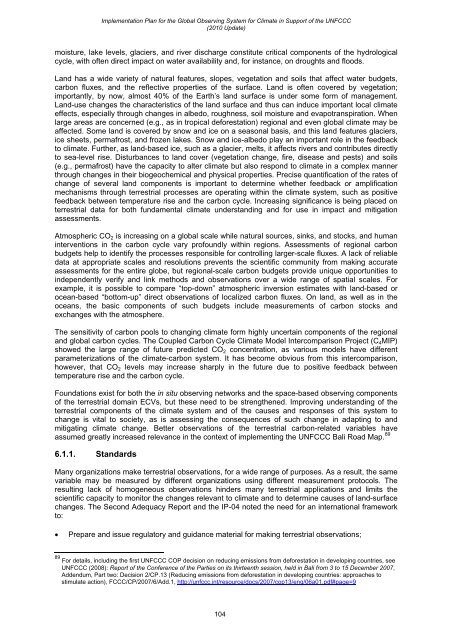GCOS Implementation Plan - WMO
GCOS Implementation Plan - WMO
GCOS Implementation Plan - WMO
You also want an ePaper? Increase the reach of your titles
YUMPU automatically turns print PDFs into web optimized ePapers that Google loves.
<strong>Implementation</strong> <strong>Plan</strong> for the Global Observing System for Climate in Support of the UNFCCC<br />
(2010 Update)<br />
moisture, lake levels, glaciers, and river discharge constitute critical components of the hydrological<br />
cycle, with often direct impact on water availability and, for instance, on droughts and floods.<br />
Land has a wide variety of natural features, slopes, vegetation and soils that affect water budgets,<br />
carbon fluxes, and the reflective properties of the surface. Land is often covered by vegetation;<br />
importantly, by now, almost 40% of the Earth’s land surface is under some form of management.<br />
Land-use changes the characteristics of the land surface and thus can induce important local climate<br />
effects, especially through changes in albedo, roughness, soil moisture and evapotranspiration. When<br />
large areas are concerned (e.g., as in tropical deforestation) regional and even global climate may be<br />
affected. Some land is covered by snow and ice on a seasonal basis, and this land features glaciers,<br />
ice sheets, permafrost, and frozen lakes. Snow and ice-albedo play an important role in the feedback<br />
to climate. Further, as land-based ice, such as a glacier, melts, it affects rivers and contributes directly<br />
to sea-level rise. Disturbances to land cover (vegetation change, fire, disease and pests) and soils<br />
(e.g., permafrost) have the capacity to alter climate but also respond to climate in a complex manner<br />
through changes in their biogeochemical and physical properties. Precise quantification of the rates of<br />
change of several land components is important to determine whether feedback or amplification<br />
mechanisms through terrestrial processes are operating within the climate system, such as positive<br />
feedback between temperature rise and the carbon cycle. Increasing significance is being placed on<br />
terrestrial data for both fundamental climate understanding and for use in impact and mitigation<br />
assessments.<br />
Atmospheric CO 2 is increasing on a global scale while natural sources, sinks, and stocks, and human<br />
interventions in the carbon cycle vary profoundly within regions. Assessments of regional carbon<br />
budgets help to identify the processes responsible for controlling larger-scale fluxes. A lack of reliable<br />
data at appropriate scales and resolutions prevents the scientific community from making accurate<br />
assessments for the entire globe, but regional-scale carbon budgets provide unique opportunities to<br />
independently verify and link methods and observations over a wide range of spatial scales. For<br />
example, it is possible to compare “top-down” atmospheric inversion estimates with land-based or<br />
ocean-based “bottom-up” direct observations of localized carbon fluxes. On land, as well as in the<br />
oceans, the basic components of such budgets include measurements of carbon stocks and<br />
exchanges with the atmosphere.<br />
The sensitivity of carbon pools to changing climate form highly uncertain components of the regional<br />
and global carbon cycles. The Coupled Carbon Cycle Climate Model Intercomparison Project (C 4 MIP)<br />
showed the large range of future predicted CO 2 concentration, as various models have different<br />
parameterizations of the climate-carbon system. It has become obvious from this intercomparison,<br />
however, that CO 2 levels may increase sharply in the future due to positive feedback between<br />
temperature rise and the carbon cycle.<br />
Foundations exist for both the in situ observing networks and the space-based observing components<br />
of the terrestrial domain ECVs, but these need to be strengthened. Improving understanding of the<br />
terrestrial components of the climate system and of the causes and responses of this system to<br />
change is vital to society, as is assessing the consequences of such change in adapting to and<br />
mitigating climate change. Better observations of the terrestrial carbon-related variables have<br />
assumed greatly increased relevance in the context of implementing the UNFCCC Bali Road Map. 89<br />
6.1.1. Standards<br />
Many organizations make terrestrial observations, for a wide range of purposes. As a result, the same<br />
variable may be measured by different organizations using different measurement protocols. The<br />
resulting lack of homogeneous observations hinders many terrestrial applications and limits the<br />
scientific capacity to monitor the changes relevant to climate and to determine causes of land-surface<br />
changes. The Second Adequacy Report and the IP-04 noted the need for an international framework<br />
to:<br />
• Prepare and issue regulatory and guidance material for making terrestrial observations;<br />
89 For details, including the first UNFCCC COP decision on reducing emissions from deforestation in developing countries, see<br />
UNFCCC (2008): Report of the Conference of the Parties on its thirteenth session, held in Bali from 3 to 15 December 2007,<br />
Addendum, Part two: Decision 2/CP.13 (Reducing emissions from deforestation in developing countries: approaches to<br />
stimulate action), FCCC/CP/2007/6/Add.1, http://unfccc.int/resource/docs/2007/cop13/eng/06a01.pdf#page=9<br />
104
















